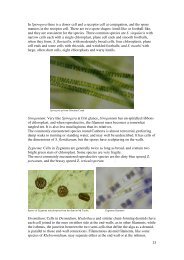Filamentous Freshwater Algae of the ACT, a preliminary list
Filamentous Freshwater Algae of the ACT, a preliminary list
Filamentous Freshwater Algae of the ACT, a preliminary list
You also want an ePaper? Increase the reach of your titles
YUMPU automatically turns print PDFs into web optimized ePapers that Google loves.
The comparable scheme for New Zealand, in Biggs (2000) separates <strong>the</strong> condition <strong>of</strong><br />
<strong>the</strong> waterway –oligotrophic (O), mesotrophic (M) and eutrophic (E)- from <strong>the</strong> algal<br />
form, and is designed for periphyton (<strong>the</strong> attached organisms on rocks and snags)<br />
ra<strong>the</strong>r than <strong>the</strong> general macroalgae. You get a score <strong>of</strong> O3 or M2 or whatever.<br />
This proposed scheme needs plenty <strong>of</strong> refining, but may be just as good as SIGNAL<br />
2, as a quick ‘spot check’. Getting <strong>the</strong> seasonality into <strong>the</strong> mix may be an<br />
interpretation (by <strong>the</strong> coordinator) ra<strong>the</strong>r than a report (by <strong>the</strong> Waterwatcher). For<br />
instance a cyanoprokaryotic crust (and accompanying floating flakes) [D, 2] in high<br />
summer is much more unwelcome than a regular mid-winter crust.<br />
In <strong>the</strong> <strong>ACT</strong>, <strong>the</strong> large artificial lakes get plankton blooms occasionally, Ginninderra<br />
less frequently than most. These blooms, especially in summer, are frequently<br />
made by <strong>the</strong> cyanobacteria Microcystis (which looks like green paint flecks or<br />
tiny strands <strong>of</strong> blue-green lace in <strong>the</strong> palm <strong>of</strong> your hand) and Anabaena (tiny,<br />
short, blue-green springs). These are both reportable organisms, and you should<br />
notify your Waterwatch Coordinator as soon as possible if <strong>the</strong>y appear in your<br />
waterway.<br />
Farm dams where <strong>the</strong> stocking rate is too high, particularly where horses or cattle are<br />
involved, go blood red with Euglena sanguinea. This is hardly surprising as <strong>the</strong> half<br />
animal-half plant enjoys a rich diet, and so goes quickly to <strong>the</strong> sporing stage. The<br />
water repellent coat on <strong>the</strong> water is made principally <strong>of</strong> encysted cells waiting to be<br />
stranded, dried and blown <strong>of</strong>f to ano<strong>the</strong>r dam! Bright green scums are frequently<br />
Botryococcus braunii; it’s a harmless green alga that just likes sunny still water with<br />
good nutrients (also <strong>the</strong> one that produces <strong>the</strong> precursor to crude oil!).<br />
12



